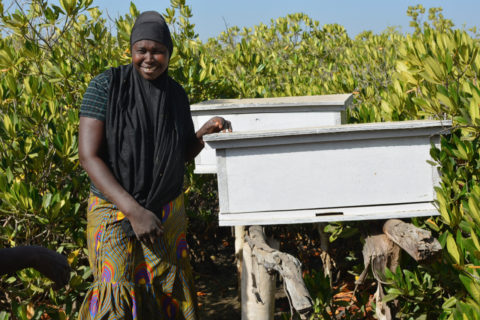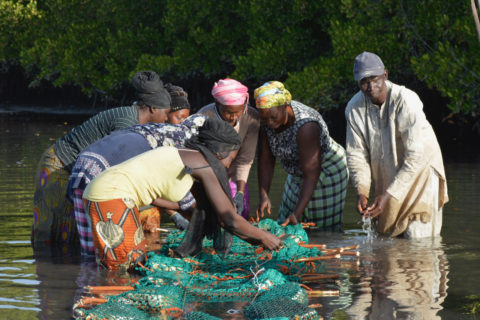
How did we make a difference in 2019 to safeguard and restore wetlands in West Africa?
-
Aquaculture, fisheries and coastal agriculture
-
Climate and disaster risks
-
Coastal resilience
-
Coastal wetland conservation
-
Community resilience
-
Integrated delta management
-
Natural infrastructure solutions
-
Wetland agriculture and fisheries
janvier 24, 2020
Here we are at the start of a new year, a year with new challenges, new activities and new opportunities to induce change, restore and conserve wetlands for people and nature.
We have a lot to look forward to in 2020, but first we’d like to present our 2019 work, sharing how we developed our four main projects and what effort it took.
We’ve achieved some great milestones and we’re delighted to continue this work in 2020.
Reducing the negative impact of infrastructure on the environment in the coastal zones of West Africa: Senegal, Mauritania, Guinea, Guinea Bissau and Cape Verde.

Construction of hotel infrastructure in Toubacouta
In 2019 with the “PRISE” project, funded by the MAVA Foundation, we were able to obtain more information and new knowledge on the situation of infrastructures that negatively affect ecosystems, while focusing on how to improve current management tools, and building the capacities of key stakeholders.
On the other hand, journalists were trained on the impact that infrastructures can have on mangroves, seagrass beds and turtle nurseries, and on how best to communicate on the subject.
In addition, training with mayors and community leaders was organized to build their capacity and encourage them to dare to stand up, defend their own habitat and learn how best to negotiate.Finally, the parliamentarians spent a week in Saloum discussing the political implications. After the workshop, the parliamentarians were encouraged to draw up a coastal management plan for their region.
Safeguarding and restoring mangrove ecosystems in Africa
The Mangrove Capital Africa (MCA) program, funded by the DOB Ecology Foundation, is our largest project to safeguard and restore mangrove ecosystems in Africa. After 2 years, phase 1 of the MCA in the Saloum Delta was concluded in 2019 with great achievements. We far exceeded our mangrove restoration target, with 195 ha compared with 150 ha planned. This is the result of the application of ecological mangrove restoration (CBMR), in addition to traditional planting. This approach has proved to deliver higher restoration success at lower cost!

Great strides have also been made in mangrove conservation.

A 30% increase in income from oysters was measured over the previous year. In addition, communities received support to improve their honey harvesting methods, leading to an increase in honey production from 40 to 120 liters!
Finally, the MCA program developed and tested a pilot program in Saloum with Mangrove school clubs, educating children about the importance and threats of mangroves, combining fun and education. 27 schools, 810 children and 54 teachers took part in this initiative. It has educated children, raised parents’ awareness of mangrove conservation and improved school performance!
Monitoring waterbirds in West Africa
Our Waterbird Counting (IWC) project focuses on monitoring waterbirds in West Africa to help us understand the health and quality of a wetland.
In 2019, we worked on improving three very important aspects: good networking, a well-functioning database and capacity building for stakeholders.
We have organized training and awareness-raising activities, which have led to more people taking an interest in monitoring activities and, interestingly, more women becoming more active and interested in bird monitoring. This is a big step forward, because the greater the enthusiasm, the bigger the network, the more relevant the data, which can give us a comprehensive picture of the situation.

A colony of egrets and spoonbills, Bamboung
In addition, we worked to clean up and restructure the databases and improve the technical capabilities of the national coordinators. Practical training was organized for network members, demonstrating the importance of the database and how it works in practice. The easier it is to work with the database, the easier it will be to encourage stakeholders to use and submit their data.
Finally, in 2019, we worked to find committed country coordinators to coordinate their country’s census and helped them improve their skills. The work will be much more structured in collaboration with these well-trained country coordinators.
Protecting and conserving seagrass beds in West Africa
Our ResilienSEA project, in partnership with GRID ARENDAL, works on the protection and conservation of seagrass beds in West Africa. For 2019, the aim was to increase knowledge of seagrass beds in dedicated areas by strengthening national and sub-regional capacities.
We organized training courses for key national players on seagrass biology and ecology, monitoring, basic mapping tools, seagrass ecosystem assessment and basic management of pilot sites. These courses have helped to raise awareness of the importance of seagrass beds. The excitement surrounding seagrasses has created more knowledge and a better understanding of the current seagrass situation in West Africa. During the exploration, more seagrasses were discovered than originally thought!

Ostreicultur in Dassilamê serrere
Overall, 2019 has been a very important year for Wetlands International Africa. Many trainings were organized, capacities were strengthened and knowledge gained.
This couldn’t have happened without the help of our great partners, donors, communities and supporters, so a big thank you to you all!
Want to find out more about our projects and achievements? In the coming days, we’ll be sharing the more detailed achievements of our thematic projects!
